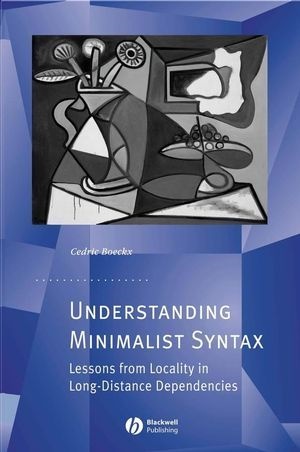Share
Fr. 156.00
Cedric Boeckx, Cedric (Harvard University) Boeckx, Boeckx Cedric
Understanding Minimalist Syntax - Lessons From Locality in Long-Distance Dependencies
English · Hardback
Shipping usually within 1 to 3 weeks (not available at short notice)
Description
Informationen zum Autor Cedric Boeckx is Assistant Professor of Linguistics and a member of the Mind/Brain/Behavior Interfaculty Initiative at Harvard University. He is the author of Islands and Chains (2003)! Linguistic Minimalism (2006)! and numerous articles in journals such as Linguistic Inquiry and Natural Language and Linguistic Theory. Klappentext Understanding Minimalist Syntax introduces the logic of the minimalist program by analyzing well-known descriptive generalizations about long-distance dependencies, and asks why they should be true of natural languages. This text proposes a new theory of how long-distance dependencies are formed, with implications for theories of locality, and the minimalist program as a whole.Experts working in the field will appreciate it's rich empirical coverage, and advanced undergraduate and graduate students will find it an accessible introduction to the minimalist program. Zusammenfassung Understanding Minimalist Syntax introduces the logic of the minimalist program by analyzing well-known descriptive generalizations about long-distance dependencies, and asks why they should be true of natural languages. Inhaltsverzeichnis Acknowledgments.1. Introductory Remarks.1.1. The Framework.1.2. Outline of the Book: Goals and Structure.2. The Marks of Successive Cyclicity (The What-Question).2.1. Subjacency and the Emergence of Successive Cyclicity.2.2. The Evidence.2.2.1. Syntax.2.2.2. Morphology.2.2.3. Phonology.2.2.4. Semantics.2.2.5. Morpho-syntactic Evidence from Overtly Stranded Pieces.2.3. A-movement.2.4. Conclusion.3. The Distribution of Intermediate Landing Sites (The Where-Question).3.1. Punctuated vs. Uniform Paths.3.2. The Difficulties Faced by Punctuated Path Hypotheses.3.2.1. Phases: An Overview.3.2.2. Conceptual Arguments for Phases.3.2.3. Arguments against Phases.3.2.4. Old Problems for Phases.3.2.5. No Empirical Argument for Phases.3.3. Conclusion.4. The Timing of Intermediate Steps of Movement (The When-Question).4.1. Early vs. Late Successive Cyclicity.4.2. Takahashi (1994).4.3. The Evidence for Early Successive Cyclic Movement.4.3.1. Background Information on Applicatives.4.3.2. The Need for Early Successive Cyclic Movement.4.4. Potential Arguments for Late Successive Cyclic Movement.4.4.1. Sub-extraction out of a Moved Element.4.4.2. Intervening Traces.4.4.3. Object Agreement.4.5. Conclusion.5. The Motivation for Intermediate Movement Steps (The Why-Question).5.1. Last Resort.5.2. Problematic Cases.5.2.1. Concord.5.2.2. Successive Cyclicity.5.3. Anti-locality.5.4. Anti-locality and Successive Cyclicity.5.5. Anti-locality and Last Resort.5.6. The Why-Question.5.7. Conclusion.6. Alternative Views on Successive Cyclicity.6.1. TAG-based Accounts.6.2. An Agreement-based Account.6.3. Prolific Domains.6.4. Greed-based Approaches.6.5. Conclusion.7. Successive Cyclicity and Other Aspects of Locality.7.1. The Standard View on Islands.7.2. Puzzles for the Standard View.7.2.1. Movement, Freezing, and Escape Hatch.7.2.2. Island by Default?.7.2.3. Island-obviation.7.3. Ross's View.7.4. Agreement and Islandhood.7.5. Conclusion.8. Concluding Remarks.References.Index...
List of contents
Acknowledgments.
1. Introductory Remarks.
1.1. The Framework.
1.2. Outline of the Book: Goals and Structure.
2. The Marks of Successive Cyclicity (The What-Question).
2.1. Subjacency and the Emergence of Successive Cyclicity.
2.2. The Evidence.
2.2.1. Syntax.
2.2.2. Morphology.
2.2.3. Phonology.
2.2.4. Semantics.
2.2.5. Morpho-syntactic Evidence from Overtly Stranded Pieces.
2.3. A-movement.
2.4. Conclusion.
3. The Distribution of Intermediate Landing Sites (The Where-Question).
3.1. Punctuated vs. Uniform Paths.
3.2. The Difficulties Faced by Punctuated Path Hypotheses.
3.2.1. Phases: An Overview.
3.2.2. Conceptual Arguments for Phases.
3.2.3. Arguments against Phases.
3.2.4. Old Problems for Phases.
3.2.5. No Empirical Argument for Phases.
3.3. Conclusion.
4. The Timing of Intermediate Steps of Movement (The When-Question).
4.1. Early vs. Late Successive Cyclicity.
4.2. Takahashi (1994).
4.3. The Evidence for Early Successive Cyclic Movement.
4.3.1. Background Information on Applicatives.
4.3.2. The Need for Early Successive Cyclic Movement.
4.4. Potential Arguments for Late Successive Cyclic Movement.
4.4.1. Sub-extraction out of a Moved Element.
4.4.2. Intervening Traces.
4.4.3. Object Agreement.
4.5. Conclusion.
5. The Motivation for Intermediate Movement Steps (The Why-Question).
5.1. Last Resort.
5.2. Problematic Cases.
5.2.1. Concord.
5.2.2. Successive Cyclicity.
5.3. Anti-locality.
5.4. Anti-locality and Successive Cyclicity.
5.5. Anti-locality and Last Resort.
5.6. The Why-Question.
5.7. Conclusion.
6. Alternative Views on Successive Cyclicity.
6.1. TAG-based Accounts.
6.2. An Agreement-based Account.
6.3. Prolific Domains.
6.4. Greed-based Approaches.
6.5. Conclusion.
7. Successive Cyclicity and Other Aspects of Locality.
7.1. The Standard View on Islands.
7.2. Puzzles for the Standard View.
7.2.1. Movement, Freezing, and Escape Hatch.
7.2.2. Island by Default?.
7.2.3. Island-obviation.
7.3. Ross's View.
7.4. Agreement and Islandhood.
7.5. Conclusion.
8. Concluding Remarks.
References.
Index
Report
"In the space of just 150 pages Boeckx provides an accessible and assured introduction to minimalism; a terrific critical review of the evidence for cyclic movement; a sympathetic yet powerful critique of phase theory; and a new approach to the cycle based on an intuitively natural version of Least Effort. This really is a tour de force and can be read profitably by expert and neophyte alike."
Norbert Hornstein, University of Maryland
"The book investigates the venerable topic of successive cyclic movement in order to shed light on the nature of the minimalist program. It is a truly impressive achievement which draws important conclusions regarding the most fundamental issues of the minimalist program and puts back the phenomenon of successive cyclic movement in the center of syntactic theorizing. It should have a strong impact on the field."
Zeljko Boskovic, University of Connecticut
"This is a concise study of how locality and anti-locality effects can be handled within minimalism: it is up-to-date, thought-provoking and full of insightful and original ideas - ideal for use as a 'specialist topic' on an advanced syntax course."
Andrew Radford, University of Essex
Product details
| Authors | Cedric Boeckx, Cedric (Harvard University) Boeckx, Boeckx Cedric |
| Publisher | Wiley, John and Sons Ltd |
| Languages | English |
| Product format | Hardback |
| Released | 04.07.2007 |
| EAN | 9781405157940 |
| ISBN | 978-1-4051-5794-0 |
| No. of pages | 192 |
| Series |
Generative Syntax Generative Syntax |
| Subjects |
Humanities, art, music
> Linguistics and literary studies
> Other languages / Other literatures
Syntax, Linguistics, Sprachwissenschaften, theoretische Linguistik, Theoretical Linguistics |
Customer reviews
No reviews have been written for this item yet. Write the first review and be helpful to other users when they decide on a purchase.
Write a review
Thumbs up or thumbs down? Write your own review.

